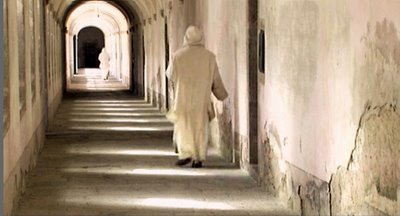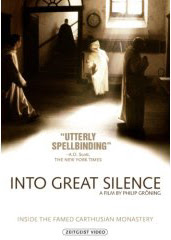When the German film Die große Stille came to Washington for a brief engagement last March, I mentioned it but never got around to writing an actual review. This week, to my great joy, a copy of the DVD release has crossed my desk. Friends near Grenoble took me to visit La Grande Chartreuse, the mother house of the Carthusian order, some years ago, but visitors are normally not allowed to come near the cloister where the monks live. In 1984, director Philip Gröning made an official request to film a documentary about monastic life there. Since the pace of modern life does not mean much within a cloister, the monks considered the request and ultimately gave their approval -- 16 years later. The result is unlike anything one could have imagined.

René-Michel Slodtz, St. Bruno (recoiling from the episcopal miter and crozier), marble, 1744, Basilica di San Pietro, Rome |
The founder of La Grande Chartreuse, St. Bruno (1030-1101, feast day on October 6), was one of the more remarkable holy men of the Middle Ages. Born in Cologne to a notable family, he rose to prominence in the church of Reims as a teacher and administrator. His reputation for learning and the eloquence of his oratory brought him prominence throughout Europe, and more than one diocese tried to press him into service as their bishop, positions he always refused. Bruno should have been one of Dante's heros, always championing monastic simplicity over the worldliness of prelates, even leading the people of Reims in a successful campaign to unseat their unpopular bishop. When he arrived with his followers at the site of La Grande Chartreuse, he thought he had found his last dwelling, but his former student Eudes of Châtillon was elected to the papacy as Urban II. Bruno answered the call to Rome to serve as papal counselor and remained in Italy, eventually founding another monastery and becoming one of the patron saints of Calabria.
In imitation of St. Bruno, the Carthusians live a semi-eremetical life, meaning that each choir monk lives in an enclosed and mostly self-sufficient hermitage, lined up in a row like little cottages. He lives in silence and isolation, for the most part celebrating the Divine Office and taking his meals alone in his cell. The community comes together for Mass daily and to sing the office, as well as eating a communal meal on Sundays and feast days. There are also lay brothers, whose daily routine is focused more on labor and who live in community. We see them in the movie, for example, walking down a long corridor and placing food or other necessities into each cell through a little door. An alluring feature of the DVD release is an hour-long excerpt from a Matins service at La Grande Chartreuse, the sound of chanting accompanied by visuals of the Latin texts being sung.

"Fenced early in this cloistral round
Of reverie, of shade, of prayer,
How should we grow in other ground?
How can we flower in foreign air?
--Pass, banners, pass, and bugles, cease;
And leave our desert to its peace!"
-- Matthew Arnold, Stanzas from the Grande Chartreuse |
In compliance with the demands of the monastic community, Gröning was essentially a one-man film crew while he shot the film over a six-month period. He introduces no artificial light, creating some stunning vistas of both interiors and exteriors, and he respects the rule of silence within the cloister. The monks do not speak directly to the camera, and we hear their voices only at the appointed times for speech -- when the prior is accepting two young men into the novitiate and during the regular walk of the monks outside the monastery. The result is an astounding immersion into the "cloistral round / Of reverie, of shade, of prayer" at La Grande Chartreuse, as Matthew Arnold put it. We see gardens being planted, water being gathered, meals being prepared, dishes being washed, habits being cut and sewn. Periodically, important monastic texts intersect the sequence of scenes.
One of my favorite verses returns several times: "You have seduced me, Lord, and I let myself be seduced." That is how Jeremiah (Chapter 20) describes the beginning of his vocation from God, a deception, a seduction, that leads him to shout prophecies that cause him to be ridiculed. When he tries to fight against the calling and keep silent, however, "there came in my heart as a burning fire shut up in my bones, and I was wearied, not being able to bear it." The only personalization of the monastic narrative, which is by definition anonymous, is that, to a degree, Gröning follows two novices as they are admitted to the community, installed in a cell, and navigate their new life. He also includes several shots of the faces of monks, which show the range of ages from the young and healthy to the emaciated body of an aged and eerily radiant monk. What is striking is the happiness and joy that pervade the community, so contrary to popular misconceptions about monastic life. This is not a place of gloom but of light-filled solitude: when you see it, one understands that these men are planted in the right place, to paraphrase Matthew Arnold.
























































No comments:
Post a Comment